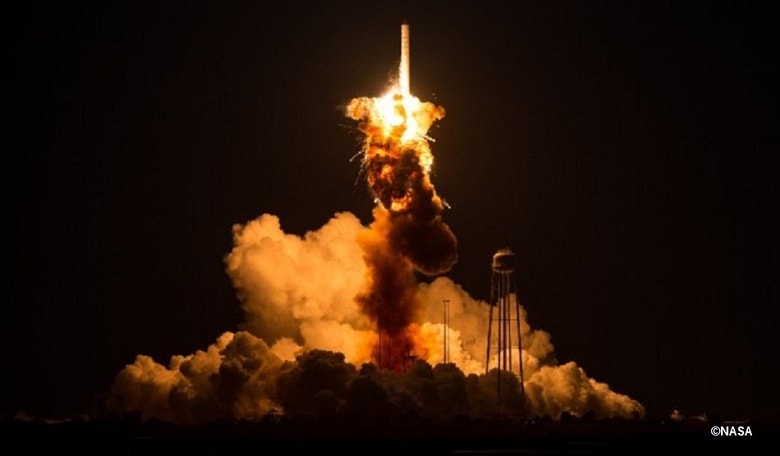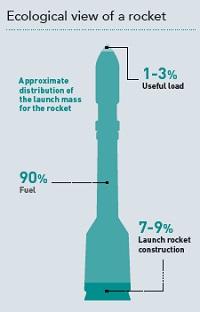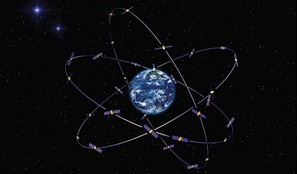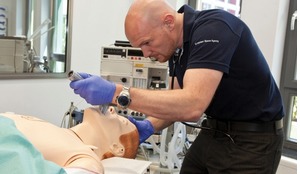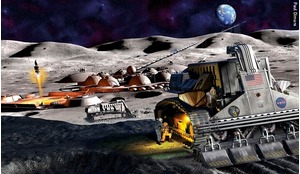Ecological issues in space technology and activity are becoming more and more important. The best space strategies for the future cannot be implemented without a move to more effective and eco-friendly technologies. Space has colossal potential to play a vital role in the future safety and stable development of humanity. However, the space industry is lagging behind in the worldwide process of moving to a green economy. Are green space equipment, technology and activity possible? And, if so, what should be the strategy for the transition to green space?
Green technology is that which allows one to achieve stated goals while using minimal resources and with the least possible environmental pollution. It has as its mission the ‘ecologisation’ of equipment and activity, and is a powerful catalyst for the transition to a new technological culture, a transformation of economy and business. Ideally, green space would only use green technology, achieving space activity goals with minimal resources and pollution.
In April 2012, Roscosmos presented a new space activity strategy, developed in the industrial market paradigm: to increase manufacturing, restore infrastructure, improve quality control and increase global market share.1 Nothing was said about protecting the environment or eco-safety, except for the battle against space debris in near-Earth orbit, which conflicted with the new Russian Federation State policy on ecological development.2 This drew public criticism of the project, including by so-called open government mechanisms. In April 2013, the President of Russia approved the foundations of the government’s policy on space activity, which includes clauses on protecting the environment.3
What are Russian goals and strategies in space? Are we flying to the Moon, or are we colonising Mars? What does society demand and how can its demands be met by the space industry? How should the industry be structured, how should work be organised and how can resources be used effectively?
Legacy of pollution
With current space equipment, military in origin, created using principles and technologies more than 50 years old, there can be no successful strategies, policies, organisational structure, funding or even new spaceports. The current modern launch rocket, for example, is far less effective than a railway engine. Only one to three per cent of the launch mass is useful load, 90 per cent is fuel (often it’s a highly toxic unsymmetrical dimethyl hydrazine – heptyl – left over from the Cold War), and the other seven to nine per cent is construction fragments that after start and separation fly out to impact areas. From an ecological standpoint, a rocket is a dirty and economically wasteful technology. It is because of humanity’s mass use of such technology during the 50 years of the space era that above-ground and near-Earth space pollution appeared and continues to grow.4,5,6
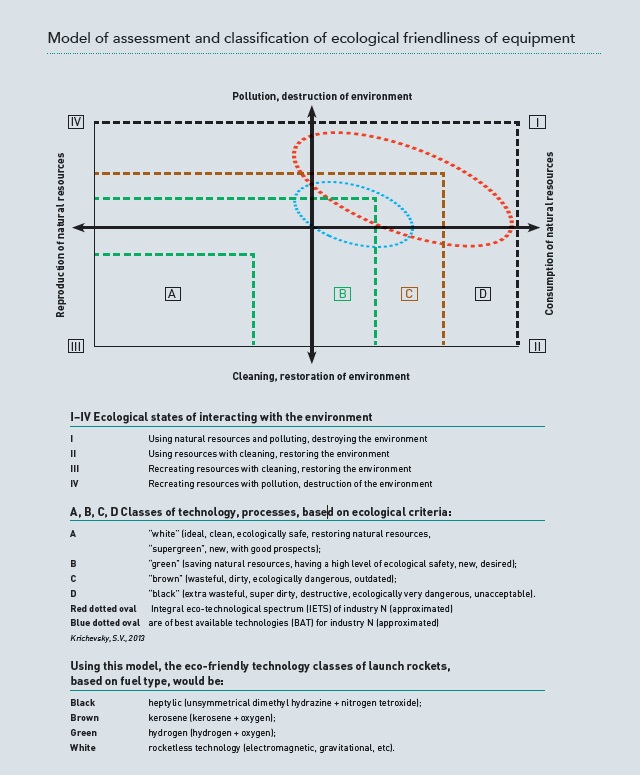
Eco-standards for automobile fuel have been in place for a long time, but they simply don’t exist for rocket fuel.7 The space industry in Russia, and in the rest of the world, is in no hurry to introduce them.
Building on my work first published in 2007, I have developed a new approach and model that allows for the assessment and classification of the ecological friendliness of equipment, technologies, processes and industries in space. These include assessments of the ‘use and replenishment of natural resources’ and ‘pollution, destruction, cleaning and restoration of the environment’.
Four colour-coded classes of technological eco-friendliness are suggested: A (white), B (green), C (brown) and D (black), where A is the most eco-friendly and D the least. The borderlines between each of the classes are relatively fluid and can adjust depending on, for example, changes in perception or the use of stricter green standards. The model can be applied to assess the eco-credentials of various technologies, individual technical objects or, by aggregating all the various technologies, activities and parts employed into a spectrum of colours, the industry itself. The greener an industry is, the less black and brown will be in the spectrum, and the more it will contain green and white. The model also allows ecological safety to be measured, based on the same four classes. Safety aspects that encompass several classes should be assessed based on the worst indicator.
Managing the ecologisation process of space technology and the level of ecological safety must be conducted through management of the spectrum of technology employed. But first an inventory of all technology used in the industry must be taken, with specific proportions and trends. Based on a preliminary assessment, the space industry is currently dominated by ‘black’ and ‘brown’ technologies and technical objects.
The proposed Vostochny Cosmodrome is important for the new government space policy, as well as for the development and security of the Amur Oblast, the Far Eastern Federal district (FEFD) and, indeed, the entire country.8,9 Vostochny will cover an area of 700-1,000 square kilometres and cost the Russian state some RUS 300 billion (2013 prices). The first launch of the Soyuz-2 rocket is planned for 2015 and the first piloted flight for 2018.
As one of the centre-pieces of the future Russian space industry, Vostochny should ideally be being built within the new paradigm of the green economy
The new cosmodrome has a long and complicated history. In the 1960s the location was used for the Strategic Missile Forces of the USSR Ministry of Defence. Then, in the early 1990s, it was dismantled, before the Svobodny cosmodrome was created there in 1996. For various reasons Svobodny was not further developed (there were only five satellite launches using solid-fuel rockets) and by order of the Russian President it was closed down in 2006. In 2007, a new initiative was started, to create an innovative national cosmodrome project and a new Russian space centre, which would become the nucleus of the space cluster in FEFD.
As one of the centre-pieces of the future Russian space industry, Vostochny should ideally be built within the new paradigm of the green economy. Unfortunately, the construction of Vostochny is currently using old technologies. Vostochny is being implemented in a hurry, without a full-scale ecological expert assessment. If this continues, the ecological colour of the new cosmodrome will be far from green.
In its defence, the cosmodrome project did not anticipate the use of new green technology from its inception and was planned and developed using pre-ecological technical and infrastructural logic. I would argue, however, that it is necessary to rethink the entire process of constructing Vostochny, not only to achieve effective budget spending and timely construction, but to ensure the cosmodrome is an effective, innovative and green facility, vital for future development of the space industry.
In July 2013, there was an accident involving the heptylic launch rocket, Proton-M, at Baikonur Cosmodrome. Three GLONASS system satellites were lost, with damages amounting to about RUB 5 billion. Fortunately, no one was hurt. The ecological damage, however, based on estimates by Kazakhstan’s authorities, came to about US$89 million.10 But even if rockets stop falling out of the sky and Vostochny works to full capacity, this won’t be enough to improve the ecological impact of the space industry.
What it needs is a green technological breakthrough: multiple-use rockets with a high-mass effectiveness, without toxic fuel, and returnable rocket stages that do not need impact areas. Such rockets, fuels and new technologies are being developed, but the transition to them has been delayed, in Russia and in the rest of the world, by 20 years. The space industry (in Russia, the USA and China) is clearly lagging behind other industries in ecological development. It is trying, without success so far, to rid itself of toxic hydrazine-heptyl fuel and single-use rockets. ‘Black’, spendthrift technology will not bring us to a green future in space.
Space industries around the world have inherited ecological problems because of their military origins
Any tried and tested technology is cheaper than a new one, and a technological breakthrough requires political willpower and incentives. Given the modern global space market, it is likely impossible to achieve in just one country, even with effective management. The entire technological approach, not just individual technologies, has to change from black to green.
But as Roscosmos was its own client, developer and controller, managing the entire Russian space industry – and the industry was, for a long time, under-financed – it is understandable that problems with product quality, safety, innovation and staff only grew with time. Rockets fell to ground way too often and equipment was replaced much too slowly (the new Angara launch rocket, for example, has been in construction since 1994). In 2013, a reform of the Russian space industry was initiated, with the creation of the United Rocket-Space Corporation, and continues to this day. Shouldn’t the green agenda also be part of the reform process?
The entire world is transitioning to a greener economy, under the new paradigm of green development as presented at the Rio+20 Conference in 2012. Green energy and transport are being developed. New demands on the space industry are imminent, demands to use the best available technology, green rockets and new methods of moving through space. Whoever is the first to embrace this process will become the true leader of the new, green wave of space and space business in the 21st century. So, is a green transition for the space industry possible? What would the overall model look like?
The ideas of ecologisation of space technology and equipment have existed since the 1990s. In the 2010s, they can be imagined as a collection of ideas about the possibilities of radical, quick transition to green space by renewing equipment and adapting green technologies.
Many innovative green space technologies have been mooted and developed, for example non-toxic rocket fuel, or using energy from laser rays to move rockets. In Russia the concept of ‘green’ technologies for space activity and a ‘green’ strategy of development for the Moon have been proposed.11 But their implementation is complicated by the prevalence of outdated, pre-ecological approaches, equipment, technologies and ways of thinking in the space industry. In other words, green space is still seen as a utopia.
Green space strategy
Space industries around the world have certainly inherited ecological problems because of their military origins. They have lagged behind in implementing higher ecological standards and transitioning to the best available technologies because of economic and other restrictions. The existing traditional projects, programmes and strategies of the space industry do not pay enough attention or allocate sufficient resources to providing ecological security and protecting the environment. Instead, space is stuck on the important issue of space debris in near-Earth space. But even this problem will not being solved, until the overall industry is ecologised. Green space strategy has to be developed as an alternative to the existing space industry strategy and/or an addition to it.
The general model of strategies for green space development can be presented in three parts: i) goals, tasks and principles; ii) main directions, methods and approaches; iii) stages.
Looking at part ii) in more detail, the main directions can be broken down as: i) providing eco-safety; ii) using natural resources on Earth and in space; iii) protecting and renewing the environment, including the creation of protected areas outside of Earth. The key methods are: standardisation and classification of eco-friendliness of equipment, technologies, projects and space programmes in four classes (the black, brown, white, green model described above). The main approaches are: i) systemic approach; ii) omnidirectional life-cycle coverage; iii) transition to a green technological way of thinking through managing the technology spectrum (prohibition of black class, limits on brown class, active support of green class and advance development of white class).
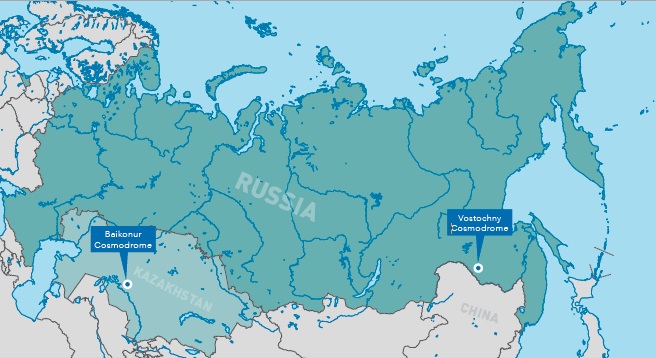 The construction of the new Vostochny Cosmodrome should be used as an opportunity to introduce the principles of green space
The construction of the new Vostochny Cosmodrome should be used as an opportunity to introduce the principles of green space
The stages involved would consist of: i) development and implementation of new rules of the game (standardisation etc); ii) a transition period (from black-brown space to green). The first stage would take approximately five years, and the second stage 20–30 years (in an optimistic scenario). The green strategy ideology, structure and logic may be presented as a system (hierarchy): i) green policy; ii) green economy; iii) green standards; iv) green technologies; v) green technological approach.
However, the green transition is impossible in space alone and/or in one country. Instead, it is determined by the speed of development of the global green economy. If the space industry continues to lag behind, it can expect to suffer from lower effectiveness and competitive edge. Yet a green future for humanity is impossible without green space.
The space industry, in Russia and in the rest of the world, its infrastructure and production, should be made from new green stock: green ideas, game rules, projects and materials. And to achieve that, everyone involved must first become a little bit green on the inside.
References
1 Davydov V.A. On the strategy of the development of the Russian space industry up till 2030 and beyond. Russian Military Industrial Complex, 2012. pp. 159–65. http://federalbook.ru/files/OPK/Soderjanie/OPK-8/III/Davidov.pdf.
2 The basis of government policy on Russia’s ecological development up till 2030 have been approved. Russian President’s website. 30 April 2012. http://news.kremlin.ru/news/15177.
3 The main points of “The basis of government policy on Russia’s ecological development up till 2030 and further on” approved by the President of the Russian Federation on 19 April 2013. PR–906. www.federalspace.ru/media/files/docs/3/osnovi_do_2030.doc.
4 Vlason M.N., Krichevsky S.V. Environmental hazards of space activity: Analytical Review. Nauka, 1999.
5 Krichevsky, S.V. Ecological history of technology (methodology, research, prospects). A study. IIET RAS, 2007. www.mosspaceclub.ru/3part/krichev/EHkologicheskaya%20istoriya%20tekhniki.pdf.
6 Krichevsky, S.V. Aerospace activity: an interdisciplinary analysis. LIBROKOM, 2012.
7 Ibid, pp. 376–7.
8 The main points of “The basis of government policy on Russia’s ecological development up till 2030 and further on” approved by the President of the Russian Federation on 19 April 2013. PR–906. www.federalspace.ru/media/files/docs/3/osnovi_do_2030.doc.
9 Vostochny Cosmodrome website. http://vostokdrom.ru/.
10 The fall of launch rocket Proton-M. RIA Novosti website, 11 June 2014. http://ria.ru/trend/accident_Proton_GLONASS_02072013/.
11 Klushnikov V. Yu. Main directions of implementing “green” technologies in the space industry. K.E. Tsiolkovsky and innovative astronautics development: Materials from XLVIII Academic reading in memory of K.E. Tsiolkovsky. Kaluga, Aidos, 2013. pp. 223–4. Krichevsky S.V. “Green” technologies and strategy of development of the Moon // Ibid. Pp. 14-16.





